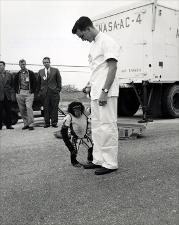Space Chimpanzee and Handler, number 2
| dc.coverage.spatial | Cape Canaveral, Florida | en |
| dc.coverage.temporal | 1961 | en |
| dc.creator | National Aeronautics and Space Administration | |
| dc.date.accessioned | 2017-08-24T22:05:22Z | |
| dc.date.available | 2017-08-24T22:05:22Z | |
| dc.date.created | 1961-02-03 | |
| dc.identifier.uri | https://hdl.handle.net/1969.1/161791 | |
| dc.description | In the foreground "HAM", the first chimpanzee ever to ride into space holds the hand of Airman Joe Pace standing in the animal compound next to Hanger 8 at Cape Canaveral. HAM looks dubiously towards the camera while shown in background from left to right are Dr. William (Bill) Ward, Dr. William E. Britz, and Dr. Harold Von Beck. Writing on the photo or group of photos: 'Cape Canaveral-Post Flight Press Conference. NASA Photo no.61-MR2-30. "Ham" the first chimpanzee ever to ride into space is shown off by his animal handler at Cap Canaveral, Fla. Ham parades in front of the press after his successful 5,000 mile an hour ride down the Atlantic missile range.' Physical description: Black and white print (photograph) 24x19mm; 15x11mm, 13x10mm negative. | en |
| dc.description.abstract | "That is Dr. William “Bill” Ward , me and Dr. Harold Von Beck in the back. Bill Ward was a physiologist in the Laboratory at Holloman, Dr. Von Beck was a German Flight Surgeon assigned to the Laboratory. I believe he was among the group of German Scientists that were acquired by the US after WW II. That is Airman Joe Pace with HAM in his flight suit which served as a restraint system by zipping into the couch . The photo was taken in our animal compound next to Hanger 8 at Cape Canaveral. Hanger 8 was where the Mercury Capsules the Astronauts were prepared for the flights. We worked out of specially built trailers for our animal housing and activities; one is in the upper right of the photo."- Dr. William Britz Shown in photo taken on February 3rd, 1961 Before he was known as "Ham , he was simply test chimp Number 65 and then named Chop Chop Chang. Before they could send humans into orbit, NASA’s scientists needed to know if spaceflight would badly slow a pilot’s reaction time. So they trained Number 65: Every time he saw a blue flashing light, he was to push a lever. If he didn’t, they shocked his feet with electricity. If he did, he got a banana pellet. On January 31, 1961, technicians strapped chimpanzee Number 65 into an 83-foot-tall Redstone rocket at Cape Canaveral and launched him into suborbital flight. The blue light flashed and the chimp pressed his lever. Sixteen minutes later, after he had ascended to an altitude of 157 miles, his pod plopped down in the Atlantic. Only then did the Air Force name him Ham, after the Holloman Aeromedical Field Lab, where he was housed. If he had died, they didn’t want the public grieving over a chimp with a lovable name. Ham made the cover of Life magazine. | en |
| dc.relation.ispartof | College of Veterinary Medicine Image Collection | en |
| dc.relation.isreferencedby | NASA. "Results of the Project Mercury Ballistic and Orbital Chimpanzee Flights". GPO: NASA SP-39. 1963. http://history.nasa.gov/SP39Chimpanzee.pdf | |
| dc.rights | It is the user’s responsibility to secure permission from the copyright holders for publication or re-use of any materials. Permission must be obtained in writing prior to publication. Please contact the Medical Sciences Library for further information. | en |
| dc.subject | National Aeronautics and Space Administration | en |
| dc.subject | Space research | en |
| dc.subject | Space sciences | en |
| dc.subject | Britz, William E. | en |
| dc.subject | Ward, William E. | en |
| dc.subject | Pace, Joe | en |
| dc.subject | Ham | en |
| dc.subject | Von Beck, Harold | en |
| dc.subject | Animal space flight | en |
| dc.subject.mesh | Space Flight | en |
| dc.subject.mesh | Research | en |
| dc.subject.mesh | Animals, Laboratory | en |
| dc.subject.mesh | Aerospace Medicine | en |
| dc.title | Space Chimpanzee and Handler, number 2 | en |
| dc.contributor.sponsor | College of Veterinary Medicine & Biomedical Sciences | |
| dc.type.material | Image | en |





